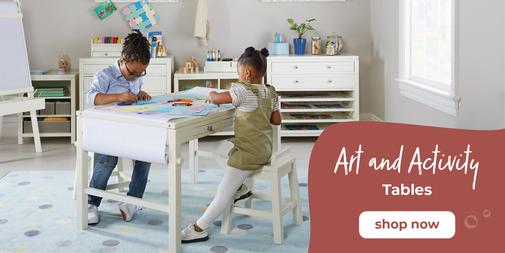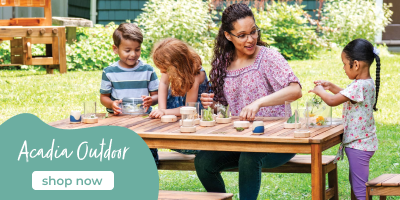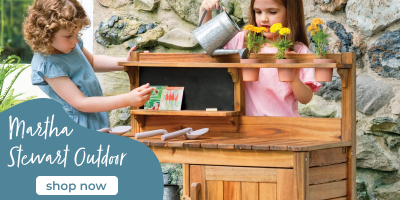Concevoir pour l'expression : comment le matériel artistique des enfants doit refléter leur façon de créer

Lorsque les enfants créent de l’art, ils sollicitent non seulement leurs mains et leur esprit, mais tout leur corps.
La création artistique est à la fois une activité de motricité fine et de motricité globale, exigeant non seulement la dextérité pour tenir un pinceau, mais aussi la liberté de bouger, d'atteindre, de s'accroupir, de s'étirer et de se pencher. Et pourtant, trop souvent, la conception des équipements artistiques pour enfants, comme les chevalets, les tables, les tabourets, les chaises et les postes de travail, ne parvient pas à s'adapter à ce processus de création complet et, ce faisant, limite non seulement leur processus créatif, mais aussi leur libre arbitre.
Le mouvement fait partie du processus créatif

Contrairement aux adultes, les enfants n'ont pas tendance à rester assis à un bureau pendant des heures. Ils bougent constamment lorsqu'ils travaillent. L'un préfère s'agenouiller par terre, un autre reste debout et se balance en dessinant, tandis qu'un autre encore se penche tellement au-dessus de la table qu'il s'y allonge presque. Ces postures ne sont pas seulement de l'agitation, elles sont essentielles à la façon dont les enfants perçoivent et maîtrisent leurs outils et leur matériel.
L'échelle, l'orientation et la liberté de mouvement dans la création artistique influencent l'œuvre finale et, plus important encore, le processus créatif lui-même. C'est pourquoi le matériel conçu pour la création artistique des enfants doit être non seulement à leur taille, mais aussi centré sur eux.
Repenser le mobilier artistique pour enfants
Prenons l'exemple du chevalet, un classique incontournable de toute classe ou atelier d'art. Trop souvent, il est conçu comme une version réduite d'un modèle adulte, avec un réglage unique de la hauteur et un angle fixe. Or, la taille, les capacités et la mobilité des enfants sont très variables, et la façon dont un enfant utilise un chevalet peut être totalement différente de celle d'un autre. Un chevalet idéal doit permettre des réglages, non seulement en hauteur, mais aussi en inclinaison et en stabilité, afin qu'il s'adapte à l'enfant, et non l'inverse.

Les tables aussi méritent d'être repensées. Les tables rectangulaires traditionnelles avec leurs chaises assorties évoquent une immobilité rare dans le travail créatif. Une approche plus flexible pourrait inclure différentes hauteurs de table, des surfaces inclinées, et même des espaces au sol avec des presse-papiers ou des tapis pour les enfants qui préfèrent travailler au ras du sol.
Les enfants aiment voyager et créer. Avoir quelque chose qu’ils peuvent utiliser dans une voiture, ou un chevalet amovible qu’ils peuvent utiliser sur le sol, ou même emporter à l’extérieur, sont des moyens pratiques d’encourager et de compléter une activité préférée.
Il est important que la conception inclusive tienne compte des enfants, quelles que soient leurs capacités physiques. Pour certains, atteindre un chevalet en hauteur est plus qu'un défi, c'est un obstacle. Un équipement adaptatif tenant compte des différentes amplitudes de mouvement, de la force de préhension et des besoins posturaux permet à davantage d'enfants de participer pleinement. Il ne s'agit pas seulement d'accessibilité, mais d'équité dans l'expression.
Il faut aussi penser aux matériaux eux-mêmes. La peinture coule. L'argile résiste. Les marqueurs glissent ou s'accrochent selon la surface. Lorsque les enfants peuvent se repositionner physiquement par rapport au support, ils en apprennent davantage sur ses propriétés et son utilisation. La création artistique devient alors non seulement un processus visuel ou intellectuel, mais aussi un processus tactile et incarné.

Faire de la place à la façon dont les enfants créent
En fin de compte, l'objectif de tout espace artistique pour enfants devrait être de favoriser l'exploration. Cela implique de créer des environnements où le mouvement est encouragé, et non restreint. Où les enfants peuvent se défouler, trouver leur rythme et découvrir comment ils préfèrent s'engager dans le processus créatif.
Les équipements artistiques doivent être des outils d’autonomisation et non des contraintes.
En concevant des espaces pour la création artistique des enfants, nous ne nous contentons pas de leur offrir des espaces où s'asseoir ou se tenir debout. Nous façonnons les conditions propices à l'épanouissement de leur imagination. En reconnaissant et en valorisant les multiples façons dont les enfants utilisent leur corps pour créer, nous laissons la place à tous les artistes et à toutes les formes d'art.













